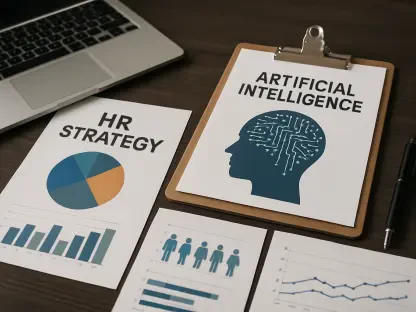The integration of machine learning (ML) into weather and climate models has become a focal point of discussions within the scientific community, highlighting both the impressive progress made and the ongoing challenges faced. The aim is to discern genuine advancements from mere exaggeration, breaking down the subtle but significant differences in how various approaches are applied to weather forecasting and climate modeling. As the complexity of data and the dimensionality of the functions these models can handle increase, it’s crucial to understand the capabilities and limitations of ML and artificial intelligence (AI) in this context.
Machine learning, in its broadest sense, refers to the statistical fitting of large datasets to complex functions, a process which includes different types of neural networks and advanced regression techniques. The rapid growth in the complexity and dimensional capacity of these functions has broadened the scope of ML applications. AI, encompassing ML, also includes expert systems and generative AI such as ChatGPT and DALL-E. Generative AI is characterized by its training on extensive datasets with numerous degrees of freedom, often reaching up to a trillion nodes. However, it is important to recognize that these systems do not possess conventional intelligence, a goal that has yet to be realized.
Recent Successes in Machine Learning for Weather Forecasting
ML has demonstrated remarkable success in enhancing weather forecasting, with systems like NVIDIA’s FourCastNet (2022), GraphCast (2023), and NeuralGCM (2024) achieving noteworthy results. These models can predict weather conditions for up to 5 to 7 days with proficiency comparable to that of traditional physics-based models. Despite these impressive capabilities, assertions that these ML systems outshine physics-based forecasts across all metrics set by the European Centre for Medium-Range Weather Forecasts (ECMWF) remain unproven.
Significant recent advancements in ML-focused weather forecasting were highlighted at the American Geophysical Union (AGU) meeting. Bill Collins presented innovations using ‘bred vectors’ with FourCastNet to create ensemble spreads that emulate the dispersion seen in chaotic physics-based models. In addition, GraphDOP represents a breakthrough by learning forecasts directly from raw observations, bypassing the conventional data assimilation and reanalysis system—a substantial methodological leap.
Despite these successes, there is an essential distinction between weather forecasting and climate modeling that must be understood. Weather forecasting primarily deals with initial value problems (IVPs), where the current state evolves predictively over a few days. This methodology does not translate well to climate projections, which are boundary value problems (BVPs) influenced by external factors like greenhouse gas concentrations and solar irradiance. The current ML systems lack a component for climate sensitivity and cannot predict the impacts of changes in these drivers due to a deficit in training data.
Distinguishing Weather Forecasting from Climate Modeling
Weather forecasting and climate modeling are fundamentally different in their approach and application. While weather forecasting entails solving initial value problems, where a specific state of the weather evolves predictively over several days, climate modeling deals with boundary value problems driven by external factors such as greenhouse gas levels, solar irradiance, and other climatic forcings. The ML systems developed so far have shown proficiency in short-term weather forecasting but lack the necessary climate sensitivity component to accurately predict the long-term impacts of various climatic drivers.
The distinction is further emphasized by the duration and variability of data available for training models. We have over 45 years of skillful weather prediction data; however, the record for climate prediction is much shorter and less varied. This discrepancy is crucial because the scenarios we aim to predict, such as climate conditions in the year 2050 or 2100, lie entirely outside the sample set. Even attributing recent climate anomalies becomes challenging for these ML models due to the absence of critical inputs like aerosol data and components of the energy balance.
To bridge these gaps and overcome these challenges, several alternative approaches have been proposed. These methods aim to enhance the applicability and accuracy of ML models for climate projections.
Alternative Approaches to Overcome Challenges
One noteworthy method is whole model emulation, which involves learning from existing climate model simulations. This approach includes utilizing perturbations to physics ensembles to identify optimal parameter sets, learning from scenario-based simulations, or conducting attribution simulations to compute attributions based on different combinations of inputs. Whole model emulation seeks to replicate the insights and behaviors of comprehensive climate models while leveraging ML’s efficiency and adaptability.
Another promising approach is process-based learning, where ML focuses on understanding specific processes from detailed and accurate process models. This method includes models like radiative transfer and convection, which can then be integrated into existing climate models to enhance computational speed and reduce biases. By concentrating on high-fidelity representations of individual processes, ML can contribute to more accurate and efficient climate simulations.
Complexity-based learning involves incorporating ML-based parameterizations from more complex models that have components like carbon cycles or interactive compositions. These rich datasets can be used within simpler models to enhance their predictive capabilities. This approach leverages the depth of complex models to refine and improve the outputs of more basic models without overcomplicating their structure.
Error-based learning is another effective method. It involves using a nudged or data-assimilated model for historical periods, saving the increments or errors, learning from them, and applying these corrections to future scenarios. This method also includes applications such as downscaling station data climate statistics with bias corrections. By learning from historical errors and applying these insights to future predictions, ML can help mitigate some of the biases that typically affect long-term climate modeling.
Potential Drawbacks and Promising Trends
Each approach to climate modeling using machine learning comes with its own challenges. Whole model emulation carries the risk of replicating the original models’ biases, while ML parameterizations must be highly stable for long-term simulations to work. Bias corrections based on past data may not accurately predict future scenarios, affecting forecast precision.
Despite these hurdles, the discussed methods are showing positive results and are continuously developing. Predicting the most successful approaches and their widespread adoption is complex, but promising trends are emerging.
One trend is using ML for tuning and calibration. ML helps fine-tune climate models through perturbed physics ensembles, enhancing the models’ precision and reliability. Several groups are already adopting this practice. Scenario emulation is another promising area where ML can emulate results for new climate scenarios before official CMIP7 scenarios become available, easing current modeling bottlenecks.
Historical emulators will allow for new attribution analyses, breaking down results by sectors, countries, or even individual fossil fuel companies. This level of detail provides actionable insights for policymakers and researchers. Additionally, the focus is shifting toward predicting changes in statistical properties at specific levels of global warming rather than predicting time series, offering more relevant insights for mitigating climate change impacts.
While ML-enhanced models will be part of the CMIP7 archive, they will likely show similar spreads in climate sensitivity as non-ML models, albeit with potentially smaller biases. Thus, ML will complement rather than replace traditional models. Purely ML-based climate models with physics-based constraints are still a work in progress, but their computational cost is lower than generative AI, avoiding carbon-intensive data centers.
In conclusion, while ML has the potential to revolutionize climate and weather modeling by handling large data more efficiently and improving predictions, the journey is incomplete. The progress will be tempered by the need for stable, unbiased methodologies and the challenge of transitioning from weather to climate modeling. Collaboration across the scientific community is essential for fully ML-driven climate prediction.









